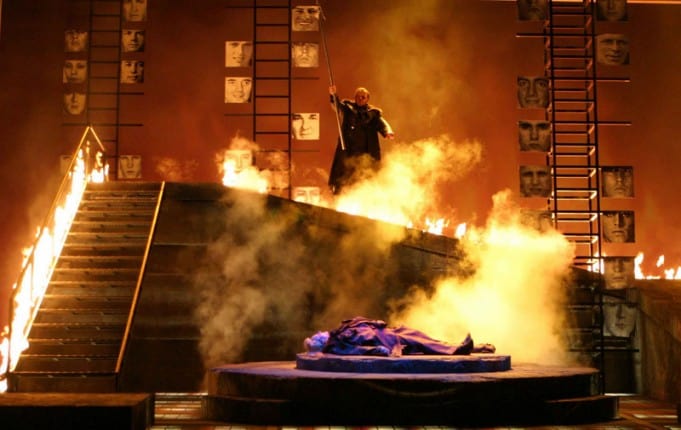Reviewing the San Francisco Opera’s 2010 production of Die Walküre is a difficult task. With an internationally recognized cast of Nina Steme as Brünnhilde, Christopher Ventris as Siegmund, Eva-Maria Westbrock as Sieglinde, and Mark Delavan as Wotan, one is more gob-smacked than critical. That being said, I’ll put this performance in some kind of perspective.
This production of Die Walküre was quite unlike anything I’ve ever seen – including the SF Opera’s production of the Ring two decades ago. This was full of surprises, which worked incredibly well for the most part. When the second act opened to Wotan as a robber baron mogul over a boardroom table with a 1930’s urban skyline out the window, I joined the audience in a collective gasp. However, this was just a warm up. Mid-way through the second act, the slaying of Siegmund took place in urban werewolf country under an unfinished highway overpass that stretched an impossible distance downstage with band of Hunding’s men. No dancing redeemable gang from West Side Story here, but rather a cast as menacingly evil as the dark side we all fear when outside our comfortable element. These surprises were all capped however, at the opening of the third act when the valkyries parachuted in, decked out as female aviators. Gone were all the Wagnerian cliché characters with their horned headpieces, shields and weapons.
Surprisingly, this did not work for everyone. I had a wonderful chat with a gentleman who flew in from Portland for the express purpose of seeing Die Walküre. A traditionalist, he needed all the Teutonic accoutrements of traditional Wagner. He noted that for him, opera had to be the right balance between make-believe and realism – and the bruises on Seigelund’s arm when she emerged from the bedroom were just too real.
Also fascinating was the heavy use of video projections during this production. I’ve always taken the position that we live in a photoshopped world – and the last place we need more of it is on stage. However, this is the second time in almost as many weeks that this technique has worked really well, so I clearly have to revise my thinking. The opening forest scene projections had a depth and fragile brilliance that took my breath away. A note from the General Director spoke of the financial challenges, complete with charts of projected expenses and realistic income. He reported that the opera was committed to “discipline ourselves to use and/or create scenic productions … including creative use of the latest video projection technologies.” If the projections in Die Walküre are a taste of things to come, we have nothing to fear.
Perhaps the most meaningful question would be why anyone would sit through anything whose run time was over four and a half hours. I confess, I struggled with that one. The overwrought emotionality of Wagner seems so very foreign – and completely exhausting. I raised the question to many folks as to why they were there, and I invariably got some variant on “because it’s the Ring.” How did this become some sort of operatic rite of passage that even non-opera fans return whenever it’s undertaken in San Francisco? I confess, I was impressed with the youth of the crowd. That a younger audience would invest this kind of time – on a weeknight no less – during an economic downturn, speaks volumes for the persistence of opera. Such things give me a great deal of hope about life, the universe and everything, which is hard enough to come by. I’ll be exploring this questions in subsequent Ring productions, and hope to have a fuller answer.
Die Walküre
San Francisco Opera, War Memorial Opera House
By Richard Wagner
4.5 out of 5 stars
Sung in German with English supertitles
The six performances of Die Walküre are scheduled for June 10 (7 p.m.), June 13 (1 p.m.), June 19 (7 p.m.), June 22 (7 p.m.), June 25 (7 p.m.) and June 30 (7 p.m.), 2010



